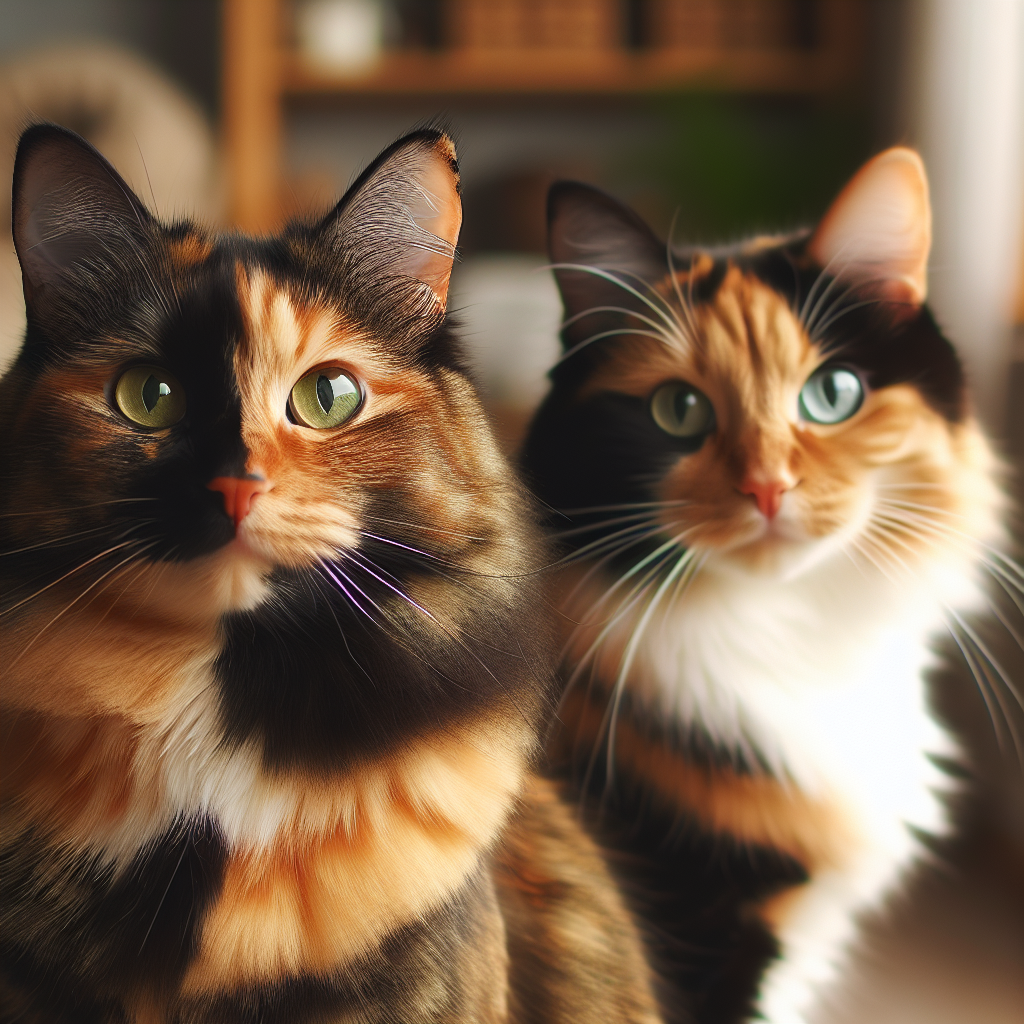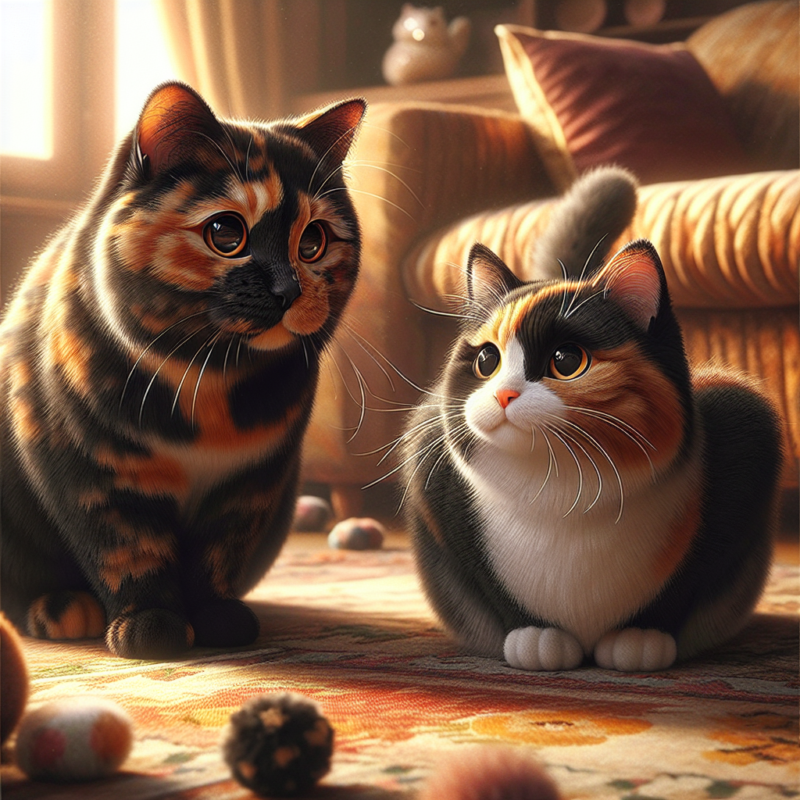About Calico kittens
Tortoiseshell cat vs calico
Tortoiseshell cat vs calico
The Genetics Behind Tortoiseshell and Calico Cats:
Tortoiseshell and calico cats are two of the most popular and beloved cat breeds in the world. With their unique and beautiful coat patterns, these cats have captured the hearts of many cat lovers. However, despite their similar appearance, there are some key differences between tortoiseshell and calico cats. These differences lie in their genetics, which play a crucial role in determining their coat patterns and colors.
To understand the genetics behind tortoiseshell and calico cats, we must first understand the basics of cat genetics. Cats have 19 pairs of chromosomes, which carry the genetic information that determines their physical characteristics. One of these pairs, known as the sex chromosomes, determines the cat’s gender. Female cats have two X chromosomes, while male cats have one X and one Y chromosome.
What Makes Them Different?
Now, let’s delve into the genetics of tortoiseshell and calico cats. Tortoiseshell cats, also known as “torties,” have a coat pattern that consists of a mix of black, orange, and sometimes white fur. On the other hand, calico cats have a coat pattern that consists of white fur with patches of black and orange. The key difference between these two patterns lies in the presence or absence of white fur.
The gene responsible for the presence of white fur in cats is called the “white spotting gene.” This gene can either be dominant or recessive, meaning it can either be expressed or hidden. In tortoiseshell cats, the white spotting gene is hidden, which is why they have minimal or no white fur. However, in calico cats, the white spotting gene is dominant, which is why they have large patches of white fur.
But what about the black and orange fur in tortoiseshell and calico cats? This is where the X chromosome comes into play. The gene responsible for the black and orange fur is located on the X chromosome. In female cats, one of the X chromosomes is randomly inactivated in each cell. This process is known as “X-inactivation.” In tortoiseshell cats, the X chromosome carrying the gene for black fur is inactivated in some cells, while the X chromosome carrying the gene for orange fur is inactivated in others. This results in the unique mix of black and orange fur in tortoiseshell cats.
Adopt a calico kitten
In calico cats, the X-inactivation process is similar, but with one key difference. As mentioned earlier, calico cats have large patches of white fur due to the dominant white spotting gene. However, this gene also affects the X-inactivation process. In calico cats, the X chromosome carrying the gene for black fur is inactivated in some cells, while the X chromosome carrying the gene for orange fur is inactivated in others. This results in the distinct patches of black and orange fur in calico cats.
It is worth noting that male cats can also have tortoiseshell or calico patterns, but it is extremely rare. This is because male cats only have one X chromosome, so they can only inherit one color gene. In order to have a tortoiseshell or calico pattern, the male cat must have a genetic abnormality where they have two X chromosomes and one Y chromosome.
Personality Traits of Tortoiseshell and Calico Cats:

Tortoiseshell and calico cats are two of the most popular and beloved cat breeds in the world. They are known for their unique and beautiful coat patterns, but they also have distinct personality traits that set them apart from other cats. In this article, we will explore the differences and similarities between tortoiseshell and calico cats, and how their personalities make them such lovable and sought-after pets.
Firstly, let’s define what makes a cat a tortoiseshell or a calico. Tortoiseshell cats, also known as “torties,” have a coat pattern that consists of a mix of black, orange, and sometimes white fur. On the other hand, calico cats have a coat pattern that includes white, black, and orange patches. While these two breeds may look similar at first glance, their personalities are quite different.
One of the most notable differences between tortoiseshell and calico cats is their level of independence. Torties are known for their strong-willed and independent nature. They are not afraid to speak their minds and will often let their owners know when they want attention or when they want to be left alone. Calico cats, on the other hand, tend to be more laid-back and easy-going. They are content with lounging around and are not as vocal as torties.
A Comparison
Another aspect that sets these two breeds apart is their energy levels. Tortoiseshell cats are known for their high energy and playful nature. They love to play and explore, and their curiosity often leads them to get into mischief. Calico cats, on the other hand, are more mellow and tend to have a lower energy level. They are content with a few play sessions throughout the day and are happy to spend the rest of their time lounging and napping.
When it comes to their interactions with humans, tortoiseshell and calico cats also have distinct differences. Torties are known for their strong bond with their owners. They are fiercely loyal and will often choose one person in the household to be their favorite. They are also known for their sassy and feisty personalities, which can make them a handful at times. Calico cats, on the other hand, are more social and tend to get along with everyone in the household. They are affectionate and love to cuddle, making them great companions for families with children.
Which is more intelligent?
In terms of intelligence, both tortoiseshell and calico cats are highly intelligent breeds. However, their intelligence manifests in different ways. Torties are known for their problem-solving skills and their ability to figure out how to get what they want. They are also quick learners and can be trained to do tricks. Calico cats, on the other hand, are more intuitive and have a strong sense of their surroundings. They are great at reading their owner’s emotions and will often provide comfort and support when needed.
One aspect that both tortoiseshell and calico cats have in common is their strong personalities. They are not afraid to express themselves and will often make their opinions known. This can make them challenging to train at times, but it also adds to their charm and makes them unique pets.
Tortoiseshell vs Calico kittens
Tortoiseshell and calico cats are two of the most unique and visually striking cat breeds. With their beautiful coats and distinct patterns, these felines are often sought after by cat lovers. However, many people may not be aware of the physical differences between these two breeds. In this article, we will delve into the characteristics of tortoiseshell and calico cats, and explore what sets them apart from each other.
Firstly, let’s define what makes a cat a tortoiseshell or a calico. Tortoiseshell cats, also known as “torties,” have a coat that is a mix of black, orange, and sometimes white. The colors are often swirled together, giving the cat a unique and marbled appearance. On the other hand, calico cats have a coat that is predominantly white, with patches of black and orange. These patches can be large or small, and the colors are usually more distinct and separated compared to a tortoiseshell cat.
One of the most noticeable physical differences between tortoiseshell and calico cats is their coat patterns. Tortoiseshell cats have a brindled or mottled pattern, while calico cats have a patchy or spotted pattern. This is due to the genetic makeup of these cats. Tortoiseshell cats have two X chromosomes, one with the orange gene and one with the black gene. As a result, their coat is a mix of these two colors. On the other hand, calico cats have three X chromosomes, with one extra orange gene. This is why their coat has more distinct patches of orange.
Understanding the Physical Differences Between These Two Unique Cat Breeds
Another physical difference between these two breeds is their coat length. Tortoiseshell cats can have both short and long hair, while calico cats are typically short-haired. This is because the gene for long hair is recessive, and calico cats do not carry this gene. However, there are rare cases where a calico cat may have long hair, but this is not the norm.
In terms of size, there is no significant difference between tortoiseshell and calico cats. Both breeds can range from small to medium in size, with an average weight of 8-12 pounds. However, it is worth noting that the size of a cat can also depend on its individual genetics and diet.
One physical characteristic that is unique to tortoiseshell cats is their “tortitude.” This term refers to the feisty and independent nature of these cats. Tortoiseshell cats are known to have strong personalities and can be quite stubborn. They are also known to be vocal and demand attention from their owners. On the other hand, calico cats are known to be more laid-back and affectionate. They are often described as friendly and easy-going, making them great family pets.
Health issues with calico kittens
In terms of health, both tortoiseshell and calico cats are generally healthy breeds. However, there is a higher chance of calico cats being born with certain health issues, such as deafness. This is because the gene for white fur, which is often present in calico cats, is linked to deafness. On the other hand, tortoiseshell cats do not have a higher risk of any specific health issues.
In conclusion, while tortoiseshell and calico cats may share some similarities, there are also distinct physical differences between these two breeds. From their coat patterns and length to their personalities and health risks, these cats have their unique traits that make them stand out. Whether you prefer the feisty and independent nature of a tortoiseshell or the laid-back and affectionate nature of a calico, both breeds make wonderful companions for any cat lover. Can you adopt a British shorthair kitten online ?

